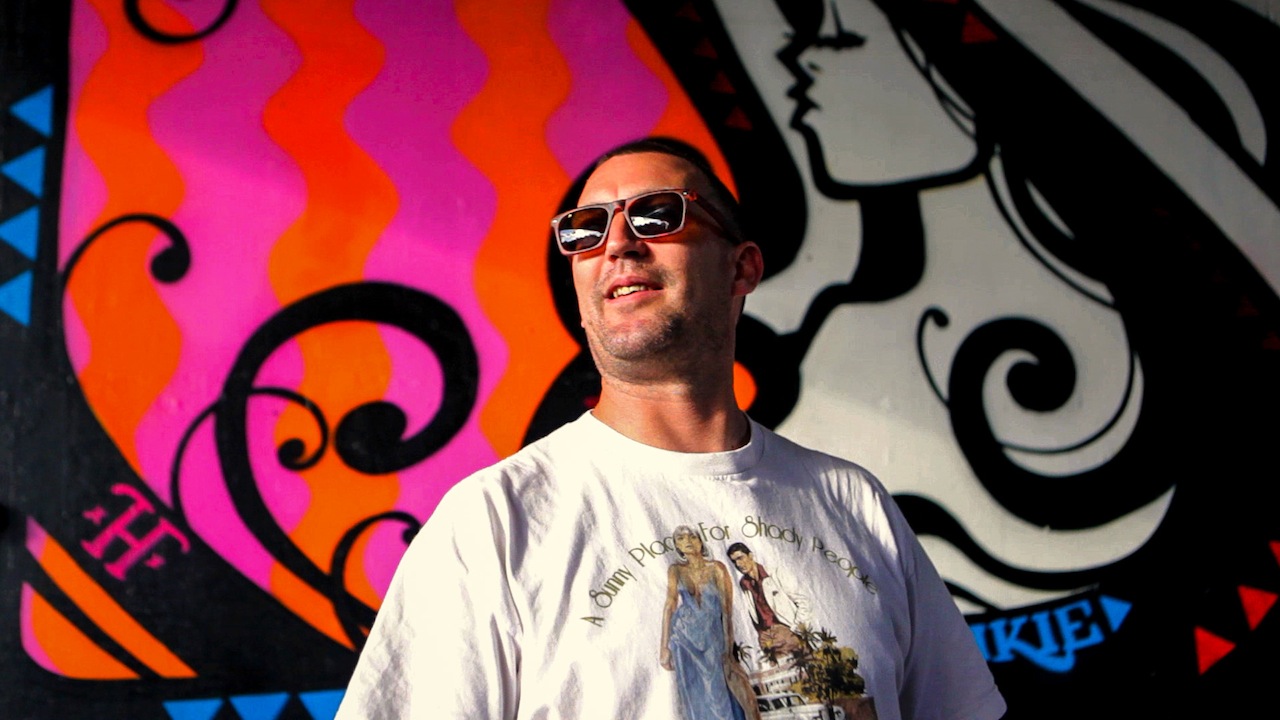It didn’t take long for graffiti to spread across the pond. The underground art form that was birthed in the train yards and streets of NYC in the late 1960s and flourished in the early 1980s quickly made its way to London. “Everything that takes off in New York, comes here about a year or two years later,” says a graffiti enthusiast in the Tim Westwood produced documentary Bad Meaning Good. Sounds about right.

As the legend goes, it was FUTURA who did the first stylized piece (pictured above) in Europe, specifically under an elevated roadway in London called the Westway while on tour with the Clash. The band commissioned him to paint backdrops live on stage while they played. The year was 1981.
“They all say that’s the first graffiti as we know it,” FUTURA told me recently. “It’s not bad for thirty years ago. Even today it wouldn’t be bad. It’s not great, but it wouldn’t be bad.”
No, it wasn’t bad at all, Lenny. Fully aligned with hip hop, which was also exploding onto the scene, graffiti culture proliferated in London and spread to Liverpool, Newcastle and, of course, Bristol, a city where it was intensely cultivated.
That’s where Tom Bingle aka INKIE hails from. “I personally like classic NYC Wildstyle,” says a broad-smiling INKIE to ANIMAL. He began painting in the early 80’s with fellow Crime Incorporated Crew members Felix “FLX” Braun and Joe Braun. As we walked under the Westway, INKIE recalls the FUTURA piece like a graffiti tour guide.
But it was Subway Art, a book by then fledgling photographers Martha Cooper and Henry Chalfant documenting the elaborate pieces painted on NYC subway trains that ultimately inspired INKIE to not only write his name on the streets, but also on trains.
I asked him why he choose the name INKIE. “First one, when we first started drawing graffiti, I just had ink everywhere, he says. “And then I started getting arrested a lot. So there’s obviously fingerprinting.” An 8-bit classic also played a role. “I was also a big arcade king, so I used to play loads of video games and the blue ghost in Pac-Man is Inkie.”

INKIE also painted alongside streets artists who were instrumental in putting Bristol on the map such as Robert Del Naja of Massive Attack aka 3D, who is credited as the first person to bring graffiti to that city and the person who took INKIE “under his wing.” He was also mates with Nick Walker, Bristol’s original stencil artist, and eventually Banksy, before he even started using stencils. Most of the other artist’s in INKIE’s crew used freehand to paint their pieces, making Banksy sort of an outcast. One of the first pieces INKIE painted with BANKSY was on a truck (pictured above). They also painted several walls together (pictured below).
“When we started out, stencils were taboo,” INKIE explains. “It was frowned upon. But looking back on it, what Banksy did was kind of clever. I could have done two-three color stencil pieces in a couple of minutes.”

In 1998, he was credited with organizing a massive and very legal public art exhibit with Banksy called “Walls on Fire” in Bristol. A poster advertising the event promoted it as “Britain’s top graffiti writers representing their skills in a massive paint battle over two days.” Although both artists are credited with throwing the event, in the book, Banksy: The Man Behind the Wall, INKIE says he was drunk most of the time, and his main contribution was giving Banksy access to his vast network of graffiti writers. It was Banksy who handled most of the logistics.
The following year, INKIE was arrested with dozens of writers as part of the UK’s biggest graffiti sting ever, dubbed “Operation Anderson.” It’s an arrest that he wears with a badge of honor and it accompanies his Facebook bio:
The ‘Kingpin’ was arrested as the head of 72 other writers in the UK’s largest ever Graffiti bust, Operation Anderson and went on to come 2nd in the 1989 world street art championships.
Despite his longstanding history and mentorship of Banksy, INKIE says he doesn’t really speak to him anymore. Sounding more disappointed than jaded, INKIE explains how the world renowned street artist got famous and forgot about all the people that helped get him to where he is today.
For the most part though, INKIE doesn’t seem like the type of person to hold grudges and still had plenty of good things to say about his old bombing partner. After all, INKIE is a formidable graffiti artist in his own right, who has gone on to create a successful career for himself doing what he loves.
He organizes one of the largest street art festivals in the world dubbed See No Evil. The Bristol-based event features hundreds of artists and thousands attend. INKIE also has an impeccable reputation amongst his fellow writers and an unbridled enthusiasm for the craft, keeping him well grounded and beaming with positivity.
For INKIE, painting continues to bring him the most joy, even if it means breaking the law. “As a graffiti artist, I love doing illegal stuff. That’s the best thing.”
You can find more about INKIE on his website, Twitter, and Facebook.



